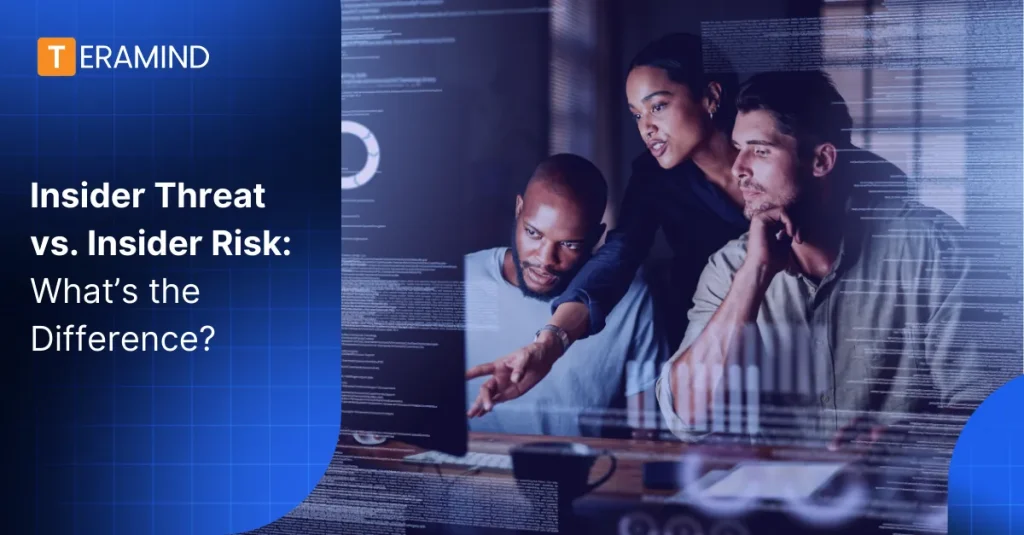Cybersecurity issues more commonly arise from insider activity than outside activity. Of course, attacks by external threat actors still occur, but insider incidents cause most data breaches and leaks.
Often, insider threat and insider risk are used interchangeably to describe cybersecurity risks posed by people with inside knowledge of a company. However, they’re not the same thing, and it’s essential to understand the differences to develop and communicate proper security policies for your organization.
What’s the Difference Between an Insider Threat & Insider Risk?
Insider risk is a security concern that arises from insider activity, from negligence and honest mistakes to the potential for malicious actions designed to harm the organization. An insider threat is an imminent, specific cybersecurity concern that aims to exploit an insider risk to damage the organization. All insider threats begin as insider risks.
What is an Insider Risk?
An insider risk is any internal factor that could represent a security concern for an organization. Insiders include employees, former employees, contractors, or business associates with access to corporate systems and knowledge of security practices.
Each individual may have personal devices that are unique endpoints on the corporate network that could be exploited. They may also have access to critical systems, third-party tools, and knowledge of security protocols, all of which could represent both unintentional or intentional insider risks.
To illustrate in less technical terms, if you leave your desk drawer open with your wallet inside, there’s a risk that someone could come and take it.
Insider Risk Examples
Negligent Insiders: One of the most common causes of data leaks and successful execution of phishing attacks is simple negligence. Employees lack the proper training, are complacent about security risks, or are fooled by malicious users outside the organization.
Compromised Insiders: Compromised insiders act intentionally against the organization. They may be disgruntled employees upset over a poor performance review, seeking retribution against coworkers or bosses they don’t like, or interested in personal gain. Either way, compromised insiders are recruited by malicious actors to provide unauthorized access to sensitive systems, share confidential digital assets for financial gain, or otherwise put the company at risk for their benefit.
Privileged Users: Privileged users are especially trusted by the organization and, therefore, given extensive access privileges that ordinary employees are not. Because they have internal access to critical assets and sensitive information, privileged users always have the potential to be risky insiders or future insider threats.
Whether they become vindictive towards the organization, are compromised by external extortion or recruitment for personal gain, or forget to turn on multi-factor authentication for specific programs, their privileged access is always a potential risk for organizations.
What is an Insider Threat?
Insider threats are when risks escalate to a more imminent likelihood of creating a security incident. There are three types of insider threats: malicious users, negligent insiders, and recruiting situations. Not all threats aren’t intentional — sometimes poorly trained or negligent insiders make mistakes that lead to security issues. Unintentional threats, however, still pose internal risks.
Using the same analogy as the last section, the risk of leaving your desk drawer open escalates to a threat when your teenage son, who always asks you for money, discovers the open drawer with your wallet inside.
Insider Threat Examples
Requesting access to files they don’t need: Users can request access to confidential files they don’t need for their job function is an insider risk. When unauthorized users request (and receive) access to those files, that is an insider threat.
Unusual USB usage: Personal devices that lack comprehensive security always pose insider risks, but when an employee transfers company data or valuable assets to a personal USB without prior approval, that constitutes a threat.
Excessive exporting: Transferring data to personal devices isn’t necessarily a threat, especially if the employee does so through the proper channels to get approval first. However, constant, extensive exporting of data to external endpoints is a red flag.
Sending files to personal emails: Most people keep their work and personal emails separate. There are a few legitimate reasons why an employee would need to send sensitive company data to their personal email. Doing so is a potential threat indicator that the employee intends to share this information further outside the scope of the organization’s cybersecurity network.
Working unusual hours: In some organizations, it’s normal for employees to work outside of typical office hours. Employee monitoring software is an excellent way to track who works outside typical hours and determine when someone works unusual hours. They may be remarkably ambitious or trying to attack the company without detection.
Examples of Insider Risks Becoming a Threat
All insider threats begin as insider risks, but not all risks escalate to become threats. These are some of the most common insider threats and how they emerge from insider risks.
Former Employee Compromises Data
There is an insider risk when an employee downloads sensitive data to a personal device. That risk becomes an insider threat when the employee decides to sell the sensitive data, potentially causing reputational harm or putting the organization at a competitive disadvantage.
This scenario often happens when former employees join a competitor, bringing trade secrets or intellectual property from their previous employer. When a former employee compromises organizational data by bringing it to a competitor or selling it on the black market, it’s a significant insider threat.
Unhappy Employee Takes Advantage of Legitimate Access
Abuse of access rights is always a potential risk. Most employees with internal access to critical systems won’t have reason to exploit that access. However, disgruntled insiders may turn from risks to threats. Whether recruited, compromised, or have a bone to pick with the company, unhappy employees can abuse authorized access to steal data or exploit security vulnerabilities.
Negligent Employee Violates Data Privacy Accidentally
Security best practices and data handling policy aren’t everybody’s strong suits. Companies must train employees on proper protocols and best practices, and employees must follow them. Employee training doesn’t automatically remove the risk of accidental insider threats.
Complacent insiders who aren’t careful may attach the wrong file in an email to external users, store customer data in an insecure location, or myriad other potential data privacy violations. A compliance violation may result in legal action, fines, or reputational damage, making this a significant insider threat.
How to Prevent Insider Risks & Threats
Ensuring that insider risks don’t escalate into threats will give your organization peace of mind. However, preventing insider risks from emerging in the first place is an even more robust security posture. There are several ways to do that.
Implement Employee & Endpoint Monitoring
Employee monitoring and insider threat solutions continuously monitor and analyze the corporate network and its various endpoints. Whether employees are in-office or have remote access, employee monitoring leverages machine learning and behavioral analytics to learn the organization’s most valuable assets, who has legitimate access privileges, how and from where assets are being accessed, employee work patterns, and many more valuable insights.
Monitoring software can flag insider risks automatically through real-time monitoring and knowledge of your organization’s systems and people. It can also send alerts when it detects potential insider threat indicators and identifies anomalous behavior and suspicious activity that may suggest a compromised insider. Thus, it is both a threat detection and security tool.
Use a Data Loss Prevention (DLP) Solution
Insiders cause most data breaches. Whether negligent or malicious insiders cause a data security incident, a DLP solution can help quickly stop or resolve the threat.
Like some other comprehensive insider risk management solutions, Teramind offers DLP software that analyzes data movement throughout your organization to avoid potential data breaches.
By understanding access privileges, user activity, and your organization’s security rules, Teramind’s DLP can intervene automatically whenever unauthorized data exfiltration occurs. It can prevent an email containing a sensitive attachment from leaving the organization, stop unauthorized users from accessing confidential files, or disable anyone from putting critical assets on personal devices.

Leverage UEBA Insights
User & Entity Behavioral Analytics (UEBA) is a security tool that analyzes user and entity activity to develop a profile of each user and endpoint’s behavioral patterns with network access.
Using those insights, it can determine risky behavior, identify unauthorized or malicious activities, and flag abnormal activities like people working outside regular hours or gaining access to systems they never have before.
By understanding each individual’s activity, job function, and what’s needed for their job role, UEBA tools paint a clear picture of normal network activity. It can then alert you to concerning anomalies and help you develop stricter access controls.
Set Up an Insider Risk Program
An insider risk program leverages technology, employee training, and organizational security standards to build a complete insider risk response. Using insider threat detection software is a critical step in creating any such program, as it will empower security teams to worry less about sniffing out risks and more about preparation, mitigation, and prevention.
Your insider risk program should have clear protocols for how the organization will respond to specific types of insider risks. That way, each security leader knows when to escalate unusual activities and how to mitigate emerging threats. Employees should feel encouraged to anonymously support suspicious behaviors and feel like they’re contributing to a culture of security.
FAQs
What is an example of an insider threat?
An example of an insider threat is when an employee with authorized access to sensitive information intentionally leaks or sells that information to unauthorized parties. Such actions can pose a significant security risk to an organization’s data and assets.
What is an insider information risk?
Insider information risk refers to the potential harm or damage that can occur when employees or insiders have access to confidential information and misuse or exploit it for personal gain or malicious purposes. This can include insider trading, unauthorized disclosure of sensitive data, or intellectual property theft.
What is the difference between an insider threat and a trusted insider?
The main difference between an insider threat and a trusted insider lies in their intentions. An insider threat is an employee who risks an organization’s security, intentionally or unintentionally. In contrast, a trusted insider refers to an employee who is trusted and has authorized access but may still present a risk if they misuse or exploit their access.
Conclusion
Employees are the lifeblood of any business, but insiders with legitimate access to company systems can also present significant risks. Through negligence, complacency, or a more malicious threat, insiders can cause financial or reputational damage to the organization. While there are many potential insider risks, it’s crucial to avoid letting those risks escalate to insider threats.
Don’t use the terms interchangeably; knowing how to classify risks vs. threats is crucial to organizing the right insider threat incident response plan and properly allocating time and resources.


